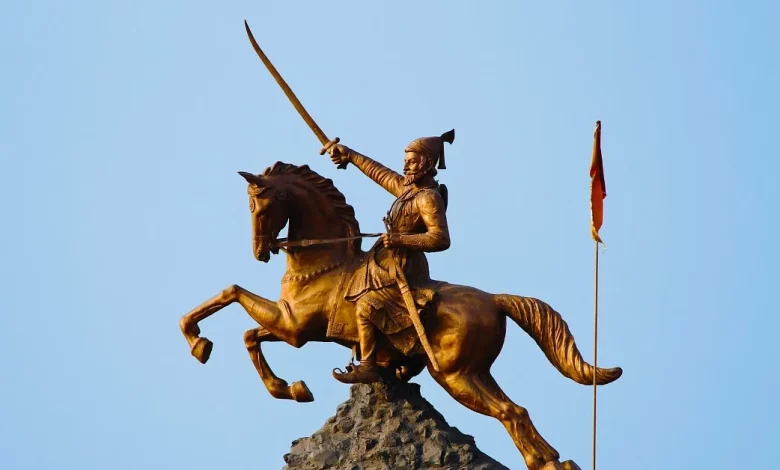
Context- In Kupwara, Jammu and Kashmir, a statue Chhatrapati Shivaji Maharaj was unveiled.
Key Highlights
- The foundation stone of the statue of Chhatrapati Shivaji Maharaj was laid by the 41 Rashtriya Rifles Maratha Light Infantry Regiment of the Indian Army in Kupwara district of northern Kashmir, which shares its border with Pakistan.
- For this, soil and water were brought from five forts viz. Shivner, Torna, Rajgad, Pratapgad and Raigad.
Chhatrapati Shivaji Maharaj
- He is one of the most revered rulers of India and is believed to have founded the Maratha Empire in the 17th century.
Early Days:
- Shivaji Maharaj was born on Shivner Hill, now located in Pune, Maharashtra.
- Shivaji is believed to be named after a local deity called Goddess Shivai.
- Shivaji’s mother Jijabai was the daughter of Lakhuji Jadhavrao of Sindkhed.
- His father Shahajiraje Bhosale was a distinguished sardari of the Deccan.
- From an early age, he showed leadership and interest in politics.
Alliance and hostilities:
- During his lifetime, Shivaji was involved in both alliances and hostilities with the Mughal Empire, Golkonda Sultanate, Bijapur Sultanate and European colonial powers.
- Shivaji’s army expanded the Maratha sphere of influence by capturing and building forts and forming the Maratha navy.
- The Maratha fleet guarded Jaigad, Sindhudurg, Vijaydurg and other forts on the Maharashtra coast.
Shivaji’s Guerrilla Tactics:
- Shivaji’s armed forces had some serious limitations.
- He lacked both manpower and horsepower compared to most of his enemies, especially in the early stages of life.
- This meant that in a normal battle, he would rarely stand a chance against his enemies.
- Unlike the plains of northern India, suitable for conventional combat with large standing armies, the terrain of the Maratha country was different.
- His men traveled in small, highly mobile and heavily armed equipment, wreaking havoc on the often slow-moving Mughal or Adil Shah armies, looting supplies and treasure and quickly retreating.
- With the Arabian Sea on one side, the Konkan plains in the middle and the Western Ghats opening onto the plains, much of the region was covered in dense jungle in the 17th century.
- Warfare in such terrain is qualitatively different, and large conventional armies tend to get stuck.
- Importance of Forts (Shivneri, Torna, Rajgad, Pratapgad and Raigad):
-
- Throughout history, before air power became a central part of military tactics and strategy, fortresses were crucial to the defense of any nation.
Geographical Factors:
- During his storied life, he conquered several such forts, including Torna (when he was only 16), Rajgadhi, Sinhagadhi and Purandar.
- Chhatrapati Shivaji Maharaj is said to have controlled over 200 forts in his territory at the time of his death, and some estimates put it at over 300.
Coronation:
- In 1674, he was crowned Chhatrapati (monarch) of his kingdom at Raigad.
Administrative and civil regulations:
- He gave the ministers separate tasks and each of them was responsible for his work to him.
- He had a Council of Ministers (Asht Pradhan) who advised him on matters of state but did not bind him.
- He also believed in religious tolerance and respected all religions equally.
- He did not make the office hereditary.
- He generally did not assign jagirs to his civil and military officials.
Arts and Culture:
- The historical figure was not only a great warrior, but also a patron of art and culture.
- He encouraged literature and music, and his court was a center of creativity and intelligence.
Death:
- The brave warrior died in 1680, but is still known for his courage and intelligence.
Modern Accounts:
- English, French, Dutch, Portuguese and Italian writers admired Shivaji for his heroic raids and humorous intrigues in contemporary accounts.
- The celebration of Shiv Jayanti was started by Jyotirao Govindrao Phule in 1870 and since then people celebrate this day with great enthusiasm.
- The celebration was organized by the great freedom fighter Bal Gangadhar Tilak.
- The freedom fighter also got the honor of drawing attention to the contribution of the Maratha King to the public during the freedom struggle.
- Bal Gangadhar Tilak described Shivaji as an “oppressor” who could have a negative impact on the colonial government.
Legacy:
- INS Shivaji of the Indian Navy is named after him.
- Chhatrapati Shivaji Terminus, formerly known as Victoria Terminus in Mumbai is also named after him.
- Shri Chhatrapati Shivaji Maharaj Memorial National Commission – Late Smt. Indira Gandhi
Conclusion:
- Unleashing his military genius and moral strength, Shivaji mobilized millions of Indians and achieved sovereignty over the Maratha Empire.
- His universal and eternal values are still important and guide us to the path of social equality and peaceful coexistence.
Source: Indian Express





.png)



